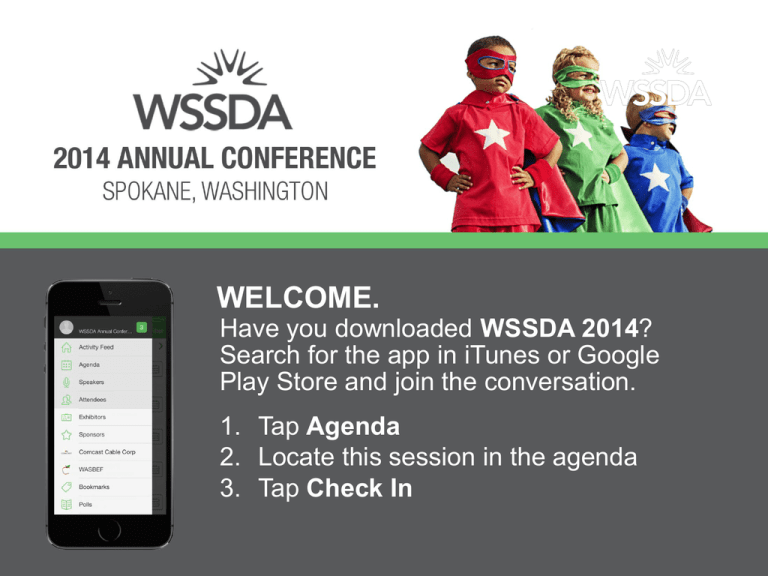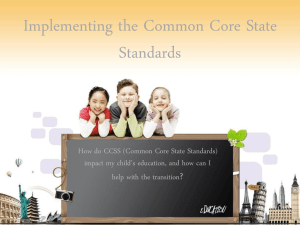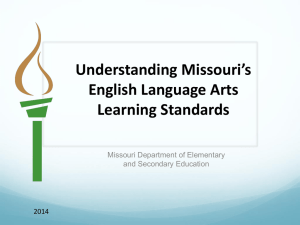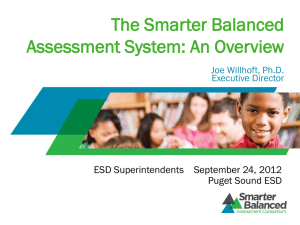Building a Comprehensive Student Achievement System for the
advertisement

WELCOME. Have you downloaded WSSDA 2014? Search for the app in iTunes or Google Play Store and join the conversation. 1. Tap Agenda 2. Locate this session in the agenda 3. Tap Check In Adding Depth and Breadth: Crafting a Balanced Assessment System Mindset (Dweck, Stanford University) Fixed Mindset Avoid Opportunities Growth Mindset Challenges Embrace Give Up Obstacles Persist in face of setbacks Effort as worthless Effort Effort path to mastery Ignore negative feedback Criticism Learn from criticism Success Of Others Find lessons and inspiration from success Threatened by others Essential Learning Outcomes • Understanding the components of assessment types and a comprehensive, balanced assessment system • Gain a detailed understanding of the data elements that can provide key information to teachers, administrators and other stakeholders • Learn the steps to crafting a balanced assessment system Is Using Student Data Effective? • The National What Works Clearinghouse reported after a meta-analysis of studies that the overall evidence is “weak” that using achievement data to support instructional decision-making will result in increased measured student performance. But, why? • The reasons for the weak empirical support is that most schools do not implement key strategies with fidelity and in a rigorous enough fashion to achieve measurable positive outcomes Key Strategies of Performance-Driven School Systems (University of Southern CA.) 1. Building a Foundation for Data-Driven Decision Making. 2. Establish a Culture of Data Use and Continuous Improvement. 3. Invest in an Information Management System 4. Select and Collect the Right Data. 5. Building School Capacity for Data-Driven Decision Making. 6. Analyze and Act on Data to Improve Performance. University of Southern California (USC) Conceptual Framework for Data-Driven Instruction in High Performing School Districts Diagnostic, Formative, Summative, progress monitoring - Balanced assessment system Data Analytic System Improvement Plans, Protocols, Monitor progress, follow through, accountability Characteristics of a High-Quality Balanced Assessment System • Multiple levels of assessment data that is relevant and actionable at each stage of the teaching and learning process. • Designed to meet the needs of key educational decision-makers, including parents. • Ability to adjust and adapt to meet the learning needs of all students through collaboration and intervention implementation. • Fit with the district mission, vision and goals. Type of Assessments within a Balanced Assessment System Categories of Assessments • • • • Summative Formative Criterion Referenced Normative Referenced Types of Assessments • Universal Screening • Diagnostics • Benchmarks or Interims • Common Formatives • Progress Monitoring • End of Term No assessment is inherently summative or formative. An assessment becomes a formative assessment when you use the information to guide current, on-going instruction Basic Balanced Assessment System Formative Benchmark TYPE: Short Term Ongoing Evaluation Strategies Periodic Diagnostic/Progress Assessments FOCUS: Student-Centered Classroom/School-Centered FEEDBACK: Frequent, immediate Feedback Multiple Data Points Across Time Summative Large-scale Assessments School /District/State-Centered Annual Snapshot Some assessments show characteristics of more than one type Continuum of Formative Assessment Stiggins (2005) Formative Assessment Assessment as Learning Assessment for Learning Assessment of Learning Daily Student Self-Assessment Student-Teacher Conference Frequent Assessments Teacher-Student Confer Guides Instruction Evaluating Students Student self assessment Responds to student needs Determines status metacognition Grading Traditional School Assessments Benchmark, Common & Summative Assessments Benchmark or Interim Assessments • Measure progress on larger units of a districts’ curriculum (EX: “quarterly benchmarks”). • Administered several times per year (EX: fall, winter, spring, quarterly). • Economical assessment. • Schools identify students in need of further intervention. • The information becomes “dated” rather quickly due to on-going instruction. Formative (Common) Assessments • Used to inform instruction • Sometimes known as “mastery monitoring” or measurement of skill mastery. • Known as “common assessments” administered after smaller segments of instruction (skills, standards, units or chapters). • Rich diagnostic information and target specific areas of learning deficits (EX: specific skills, knowledge, standards). • Examples: classroom assessments, observations, quizzes, unit exams, locally-developed standards-based assessments. Summative Assessments • Administered well after the material is taught. • Does not generally affect the current, on-going instruction for students. • Often used for grading students. • Can be used to measure growth of students • Provides feedback to teachers as to how to improve classroom instruction in the future. • Informs stakeholders how students or the system progressed during a given time frame. • Examples: State NCLB assessments (EOC End of course tests, ACT, SAT, AP) Summative Assessment Data May Suggest: • • • • • • • Changes in curriculum Changes in instructional strategies Changes in staffing ratios or class sizes Changes in course offerings Changes in entire programs Focused professional development Determination of value added & teacher effectiveness But, will not affect the teaching and learningof current students. Moving Towards a More Comprehensive Assessment Plan Universal Screener, Diagnostic, Progress Monitor, Computer Adaptive Universal Screening Assessments • Skill based, economical assessments, not standards based and typically administered in reading and math. • Used as an early warning system for prediction of performance on high stakes accountability assessments. • Screening for students at risk within an RtI Model. • Excellent for measuring growth over time Examples: AIMSWeb, NWEA, aFAST, DIBELS Diagnostic Assessments • Standards-based assessments often provide data that is not specific enough to design targeted instruction. • Assess micro skills or learning targets. • Can be a formal or informal tool. Often is a performancebased assessment to measure student response. • Students receiving tier II or tier II interventions may require assessments that drill down to measure very specific subskills in reading or math. • Example: Phonics assessment that each and every phonic skill that student knows and does not know; Math fact fluency assessment dx of specific math algorithms Progress Monitoring • Used as a type of formative assessment for RtI. • The assessment is very efficient to administer. • Tier II or tier III interventions • require very frequent progress monitoring assessments and will allow for measurement of small incremental improvement. • • Highly focused on one or two skills/standards by the targeted intervention. • The assessment often has national norms for expected growth trajectories. The data can be displayed to show discrepancy between where the student is performing relative to the expected level. The data can be graphed to measure a change in rate of progress relative to expected growth over time. Progress Monitoring Rate of Progress - Low Slope 60 50 40 30 20 10 Measurement # or Date 35 33 31 29 27 25 23 21 19 17 15 13 11 9 7 5 3 0 1 Performance Score 70 Progress Monitoring - Rate of Progress - High Slope 60 50 40 30 20 10 Measurement # or Date 35 33 31 29 27 25 23 21 19 17 15 13 11 9 7 5 3 0 1 Performance Score 70 Computer Adaptive Assessments • Can drill down to the content, skill and standard grade level • Nationally-standardized in reading, math, science and English (K-12 depending on test). • EX: NWEA MAP, aFAST System, Let’s Go Learn INVESTING IN THE RIGHT DATA SYSTEM The Right Data System • Robust platform to store and report all student data in effective ways. • All the data must be one convenient place for staff and administration. • A Few Key Elements: • Student/Parent Portal access • Customizable, interactive data dashboards for teachers and Admin • System integration and data importing • Deliver a variety of • • • • • paper Available item banks Assessments linked to standards for reporting High level data analysis for single and multiple measures Longitudinal analysis capabilities Captures and reports student performance in all areas (EX: behavior) Creating the Assessment Vision at the District Level The Literature suggests……… The majority of districts simply do not develop a systematic, longitudinal plan around assessment and data utilization. Balanced Assessment System – Step 1 Develop a District Assessment Leadership Team • Creates the vision authority • Curriculum & instruction • Assessment staff • Drives implementation • Teacher reps • Sets goals and targets • Admin reps • Monitors progress • Special group reps (psychs, • Collects feedback to improve system Collaboration is KEY! • Includes various stakeholders: counseling, health, non-core areas) Balanced Assessment System – Step 1 School Assessment Leadership Teams • Each School has a team that reports back to the district leadership team • Helps design and create assessments as appropriate • Include team members from various areas: • Principals. • Teacher reps from all core areas • Special group reps (psychs, counseling, health, non-core areas) • Implements the vision • Drives school & classroom level implementation • Monitors goals and targets • Provides feedback loop to district team to improve system Collaboration is KEY! Balanced Assessment System – Step 2 Inventory All Current Assessments Being Administered – Identify types of assessments being given across the various grade levels in the target content area(s) and for what specific reason. – How is the data being used? Are the results demonstrating the data protocols are working? – Why is each assessment being administered? What are the gaps? Balanced Assessment System Step 3 Stakeholder Group Analysis “Does your current inventory of assessments meet the data needs of all groups? – Which stakeholder groups need assessment data? – Parents, admin, teachers, students, school board, community, state, federal – What are the decisions and questions that need to be addressed by each group? – What specific assessment information needs to be provided to each stakeholder group? Rarely do districts analyze their system from this perspective Balanced Assessment System Step 4 Identification of curricular areas that require assessment data • Reference back to the stakeholder analysis • Core academic areas: Math, ELA, Science, Social Studies • Non-Core areas: music, PE, world languages • ESL, Gifted/talented, Special education • AP, CTE/ROP Balanced Assessment System Step 5 Create an Assessment Alignment Map for each curricular area identified in Step 4 • Map the information from stakeholder groups in step 2 to the appropriate assessment approaches. • Stakeholder groups – What data is needed from each assessment method? • For each curricular/programmatic need, what info is obtained from each method? • What are the strengths of each method? • **This is where mistakes are made! Do not jump to selection of specific tools and vendors. Can lead to the point where people ask: “Why do we give this assessment anyway?” Math – Grade 3 Assessment Type Screening Benchmark Formative Summative Students Areas to grow Areas of strength % correct Standards msty % correct Standards mastery Prof. Level Teachers ID at-risk ID needs Grouping needs Student instr. Needs, grouping Item analysis Standards mast. Classroom % Item analysis Standards mast. Instrctnl needs strand data, proficiency level Overall effect Admin ID at-risk x teacher x grade x school Broad areas of need/strength RtI Selection Crit. Data x teacher, building, district overall compare, RtI Growth levels Selection Crit. Data x teacher, building, district overall Data x teacher, building, district overall Parents Area of concern Strengths Comparisons NPR NPR, 3x yr. Growth level grades Proficiency status, ontrack Yearly growth data none AYP status District Trends District trends District trends District overall none none AYP status State Growth Community Board State/Feds %age of at-risk x grd Diagnostic C. Balow, 2011 Balanced Assessment System Step 6 • • Create Assessment Infrastructure • Determine timeline for assessments to be in place. • Determine administration frequency & timelines • Determine who will conduct the assessment & logistics • Determine where the data will go and how it will be accessed and reported. • How will your assessments be created? Prebuilt or homegrown? • Will your assessments use purchased item banks or create your own items? Assessment Infrastructure • Determine cut-scores, targets, proficiency levels of the various criterion-based measures. • Determine specific program selection criteria. • Logistic regression prediction models to determine students if are “on-track” to achieve specified outcomes. • Who maintains & reports out the data? C. Balow, 2011 A Quick Summary 1. 2. 3. 4. 5. Create district and school assessment teams Inventory current assessments in use Identify key stakeholder groups (key questions) Identify content areas in need of assessment data Determine Data requirements by stakeholder group (Assessment Data Alignment Map) 6. Complete Assessment Approaches/Measures Map x content area x grade 7. Design assessment delivery infrastructure and timelines Thank You Abram Jimenez ajimenez@illuminateed.com (213) 280-1122 THANK YOU FOR ATTENDING. We’d love to have your feedback. Take a moment to participate in a quick survey about this session in WSSDA 2014. 1. Tap Agenda 2. Locate this session in the agenda 3. Tap Check In (if you haven’t already) 4. Tap Take Survey








